Abstract
A defined agar medium (hereinafter designated caprylate-thallous [CT5 agar) containing 0.01% yeast extract, 0.1% caprylic (n-octanoic) acid, and 0.025% thallous sulfate is highly selective for all Serratia species and effectively discriminates against most non-Serratia strains likely to be in the same habitats. The selectivity of CT agar is demonstrated by the very high efficiency of colony formation (mean, 80.7% of that on a nonselective complex medium) on CT agar by known Serratia strains and the very low efficiency of colony formation (close to zero) on CT agar by bacterial strains known not to be Serratia. The utility of this medium in actual clinical laboratory practice is demonstrated by the more rapid and higher recovery of Serratia on this selective medium as compared to conventional procedures of in-tandem runs of 513 consecutive urine, feces, and sputum specimens. Pigmented and nonpigmented Serratia strains deliberately added to fecal specimens can be selectively and quantitatively recovered on CT agar. CT agar compares favorably with, or in some cases is an improvement over, other selective media which have been recommended for isolating Serratia. This selective CT agar medium could be quite useful in ecological surveys, especially those related to hospital-acquired infections.
Full text
PDF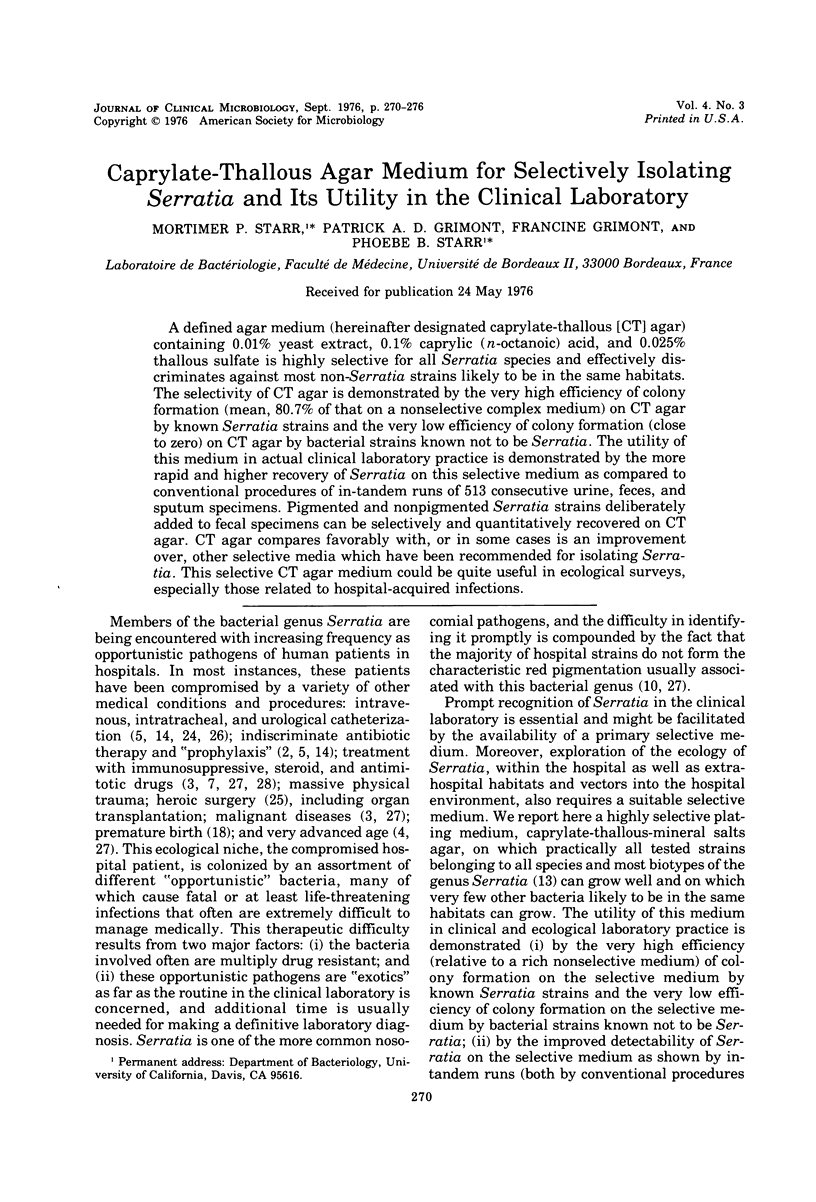
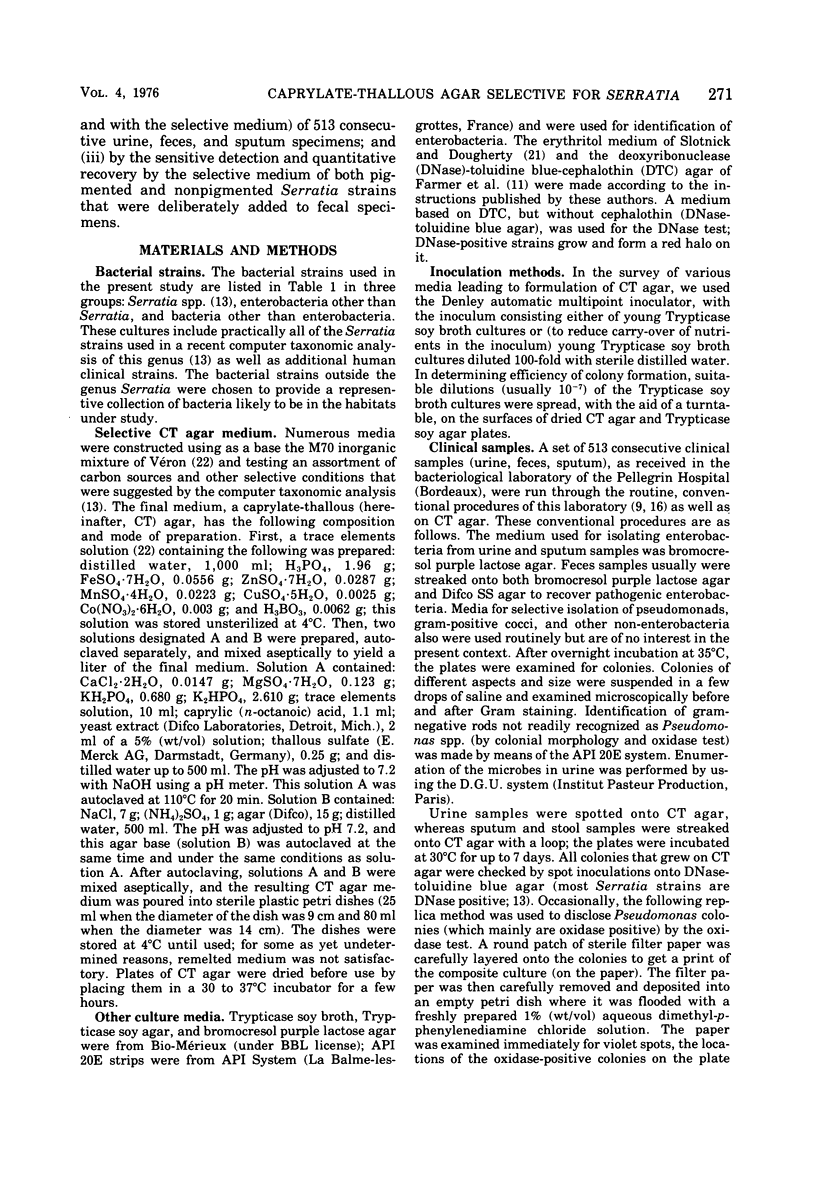
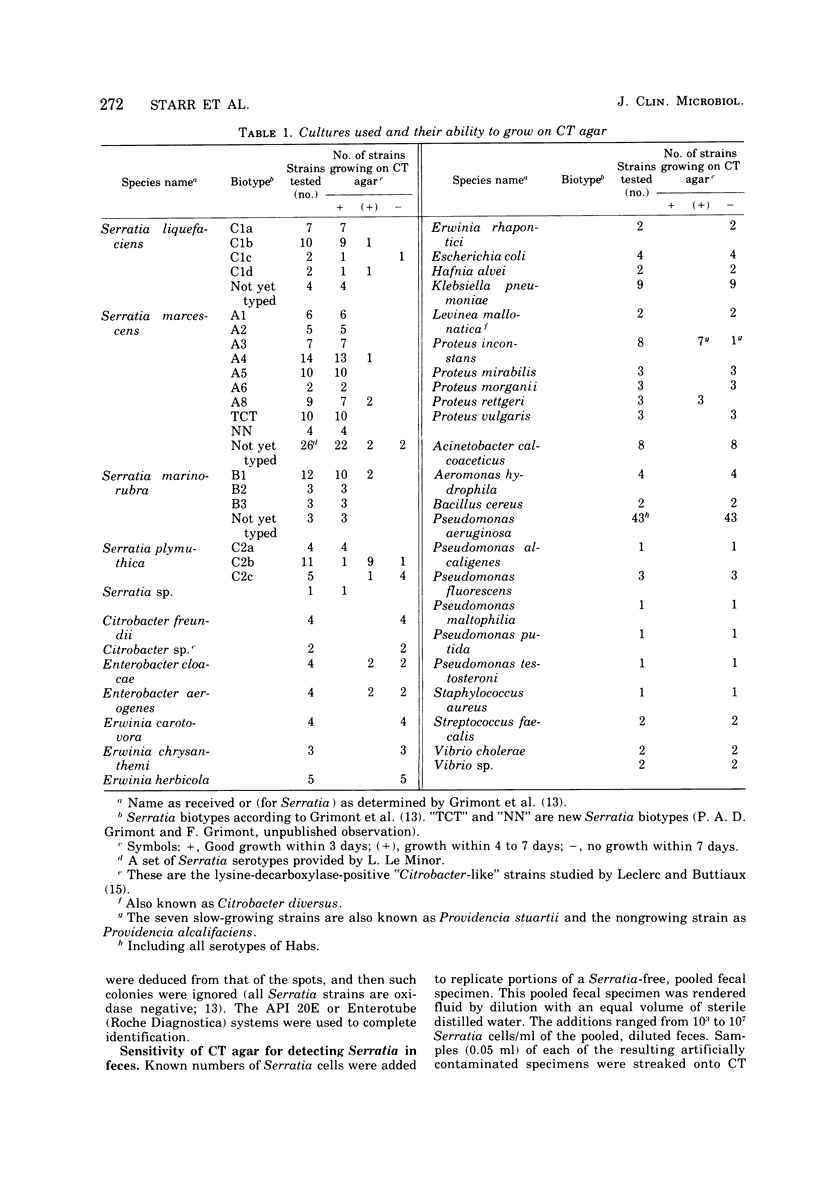
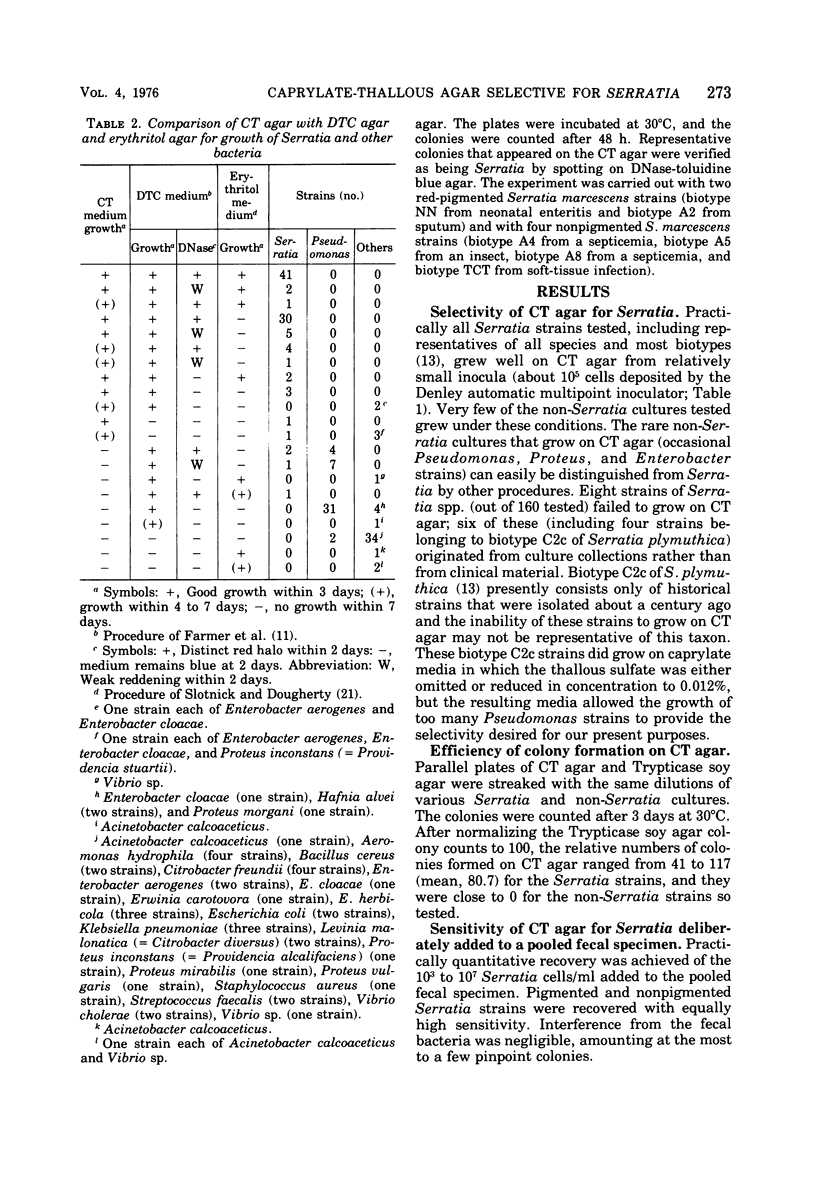
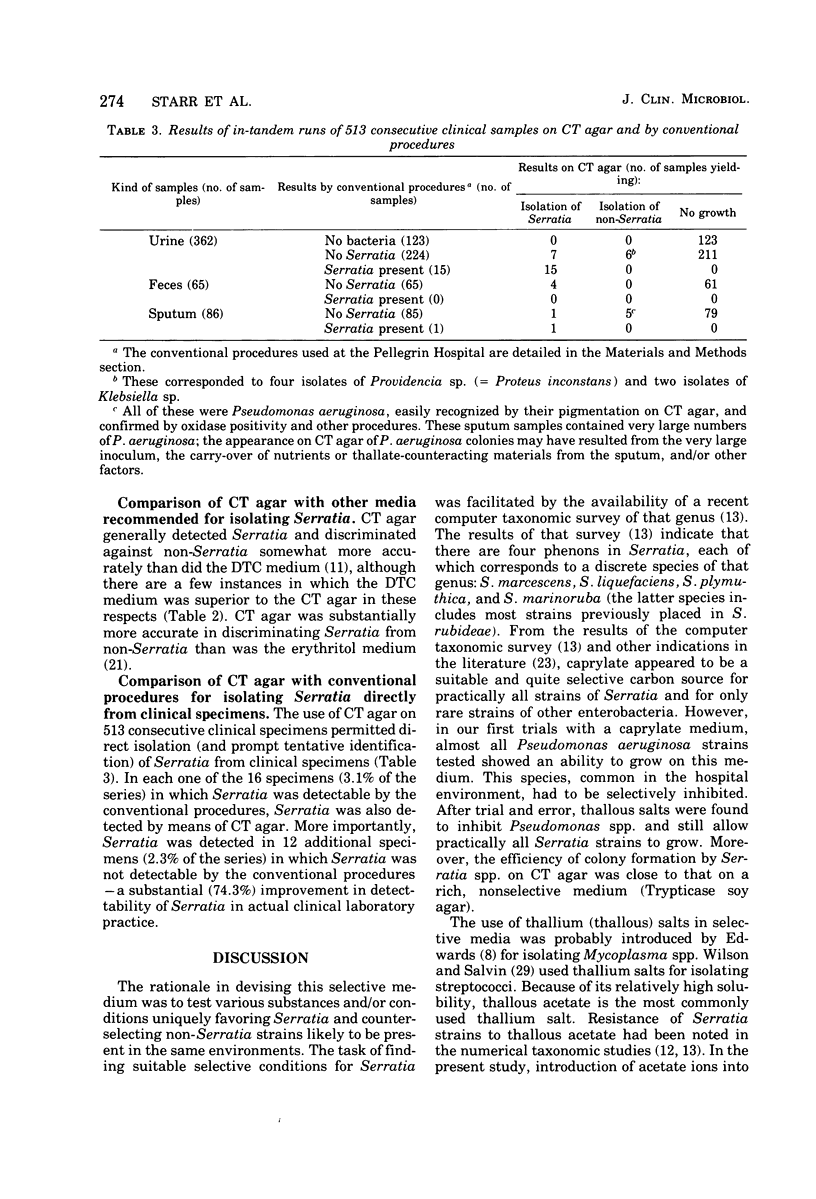
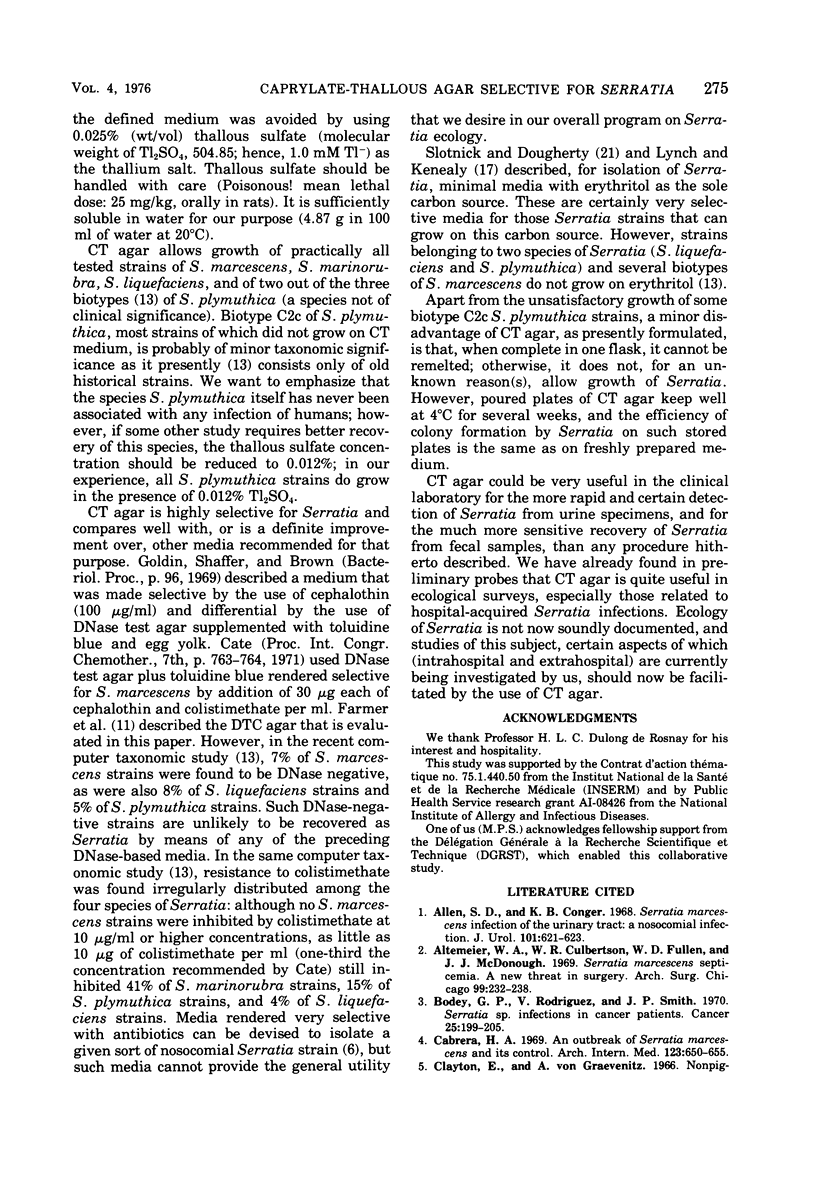
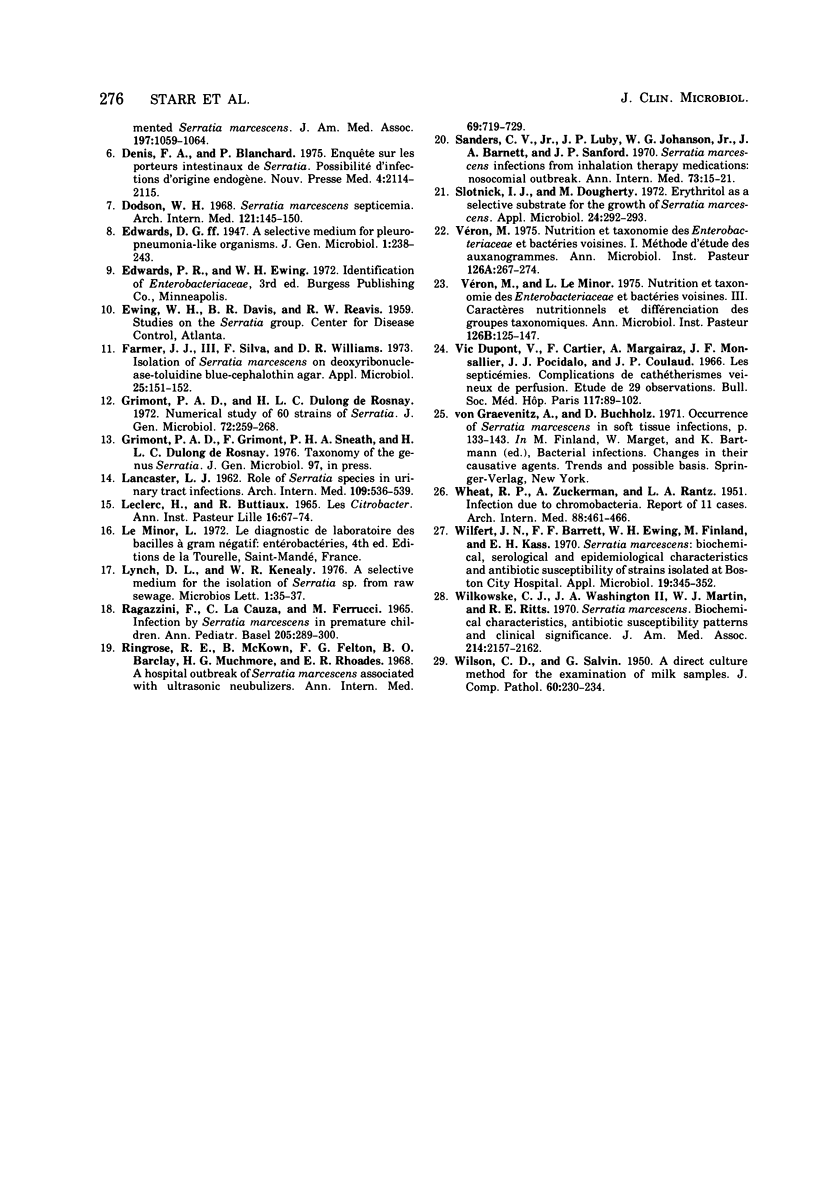
Selected References
These references are in PubMed. This may not be the complete list of references from this article.
- Allen S. D., Conger K. B. Serratia marcescens infection of the urinary tract: a nosocomial infection. J Urol. 1969 Apr;101(4):621–623. doi: 10.1016/s0022-5347(17)62391-7. [DOI] [PubMed] [Google Scholar]
- Altemeier W. A., Culbertson W. R., Fullen W. D., McDonough J. J. Serratia marcescens septicemia. A new threat in surgery. Arch Surg. 1969 Aug;99(2):232–238. doi: 10.1001/archsurg.1969.01340140104015. [DOI] [PubMed] [Google Scholar]
- Bodey G. P., Rodriguez V., Smith J. P. Serratia sp. infections in cancer patients. Cancer. 1970 Jan;25(1):199–205. doi: 10.1002/1097-0142(197001)25:1<199::aid-cncr2820250128>3.0.co;2-4. [DOI] [PubMed] [Google Scholar]
- Cabrera H. A. An outbreak of Serratia marcescens, and its control. Arch Intern Med. 1969 Jun;123(6):650–655. [PubMed] [Google Scholar]
- Denis F. A., Blanchard P. Enquête sur les porteurs intestinaux de Serratia. Possibilité d'infections d'origine endogène. Nouv Presse Med. 1975 Sep 13;4(29):2114–2115. [PubMed] [Google Scholar]
- Dodson W. H. Serratia marcescens septicemia. Arch Intern Med. 1968 Feb;121(2):145–150. [PubMed] [Google Scholar]
- Farmer J. J., 3rd, Silva F., Williams D. R. Isolation of Serratia marcescens on deoxyribonuclease-toluidine blue-cephalothin agar. Appl Microbiol. 1973 Jan;25(1):151–152. doi: 10.1128/am.25.1.151-152.1973. [DOI] [PMC free article] [PubMed] [Google Scholar]
- Grimont P. A., Dulong de Rosnay H. L. Numerical study of 60 strains of Serratia. J Gen Microbiol. 1972 Sep;72(2):259–268. doi: 10.1099/00221287-72-2-259. [DOI] [PubMed] [Google Scholar]
- LANCASTER L. J. Role of Serratia species in urinary tract infections. Arch Intern Med. 1962 May;109:536–539. doi: 10.1001/archinte.1962.03620170034005. [DOI] [PubMed] [Google Scholar]
- Leclerc H., Buttiaux R. Les Citrobacter. Ann Inst Pasteur Lille. 1965;16:67–74. [PubMed] [Google Scholar]
- Ragazzini F., La Cauza C., Ferrucci M. Infection by Serratia marcescens in premature children. Ann Paediatr. 1965;205(4):289–300. [PubMed] [Google Scholar]
- Ringrose R. E., McKown B., Felton F. G., Barclay B. O., Muchmore H. G., Rhoades E. R. A hospital outbreak of Serratia marcescens associated with ultrasonic nebulizers. Ann Intern Med. 1968 Oct;69(4):719–729. doi: 10.7326/0003-4819-69-4-719. [DOI] [PubMed] [Google Scholar]
- Sanders C. V., Jr, Luby J. P., Johanson W. G., Jr, Barnett J. A., Sanford J. P. Serratia marcescens infections from inhalation therapy medications: nosocomial outbreak. Ann Intern Med. 1970 Jul;73(1):15–21. doi: 10.7326/0003-4819-73-1-15. [DOI] [PubMed] [Google Scholar]
- Slotnick I. J., Dougherty M. Erythritol as a selective substrate for the growth of Serratia marcescens. Appl Microbiol. 1972 Aug;24(2):292–293. doi: 10.1128/am.24.2.292-293.1972. [DOI] [PMC free article] [PubMed] [Google Scholar]
- Véron M., Le Minor L. Nutrition et taxonomie des enterobacteriaceae et bactéries voisines. III. Caractères nutritionnels et differenciation des groupes taxonomiques. Ann Microbiol (Paris) 1975 Sep;126(2):125–147. [PubMed] [Google Scholar]
- Véron M. Nutrition et taxonomie des Enterobacteriaceae et bactéries voisines. I. Méthode d'étude des auxanogrammes. Ann Microbiol (Paris) 1975 Apr;126(3):267–274. [PubMed] [Google Scholar]
- WHEAT R. P., ZUCKERMAN A., RANTZ L. A. Infection due to chromobacteria; report of 11 cases. AMA Arch Intern Med. 1951 Oct;88(4):461–466. doi: 10.1001/archinte.1951.03810100045004. [DOI] [PubMed] [Google Scholar]
- WILSON C. D., SLAVIN G. A direct culture method for the examination of milk samples. J Comp Pathol. 1950 Jul;60(3):230–234. doi: 10.1016/s0368-1742(50)80022-x. [DOI] [PubMed] [Google Scholar]
- Wilfert J. N., Barrett F. F., Ewing W. H., Finland M., Kass E. H. Serratia marcescens: biochemical, serological, and epidemiological characteristics and antibiotic susceptibility of strains isolated at Boston City Hospital. Appl Microbiol. 1970 Feb;19(2):345–352. doi: 10.1128/am.19.2.345-352.1970. [DOI] [PMC free article] [PubMed] [Google Scholar]
- Wilkowske C. J., Washington J. A., 2nd, Martin W. J., Ritts R. E., Jr Serratia marcescens. Biochemical characteristics, antibiotic susceptibility patterns, and clinical significance. JAMA. 1970 Dec 21;214(12):2157–2162. doi: 10.1001/jama.214.12.2157. [DOI] [PubMed] [Google Scholar]


